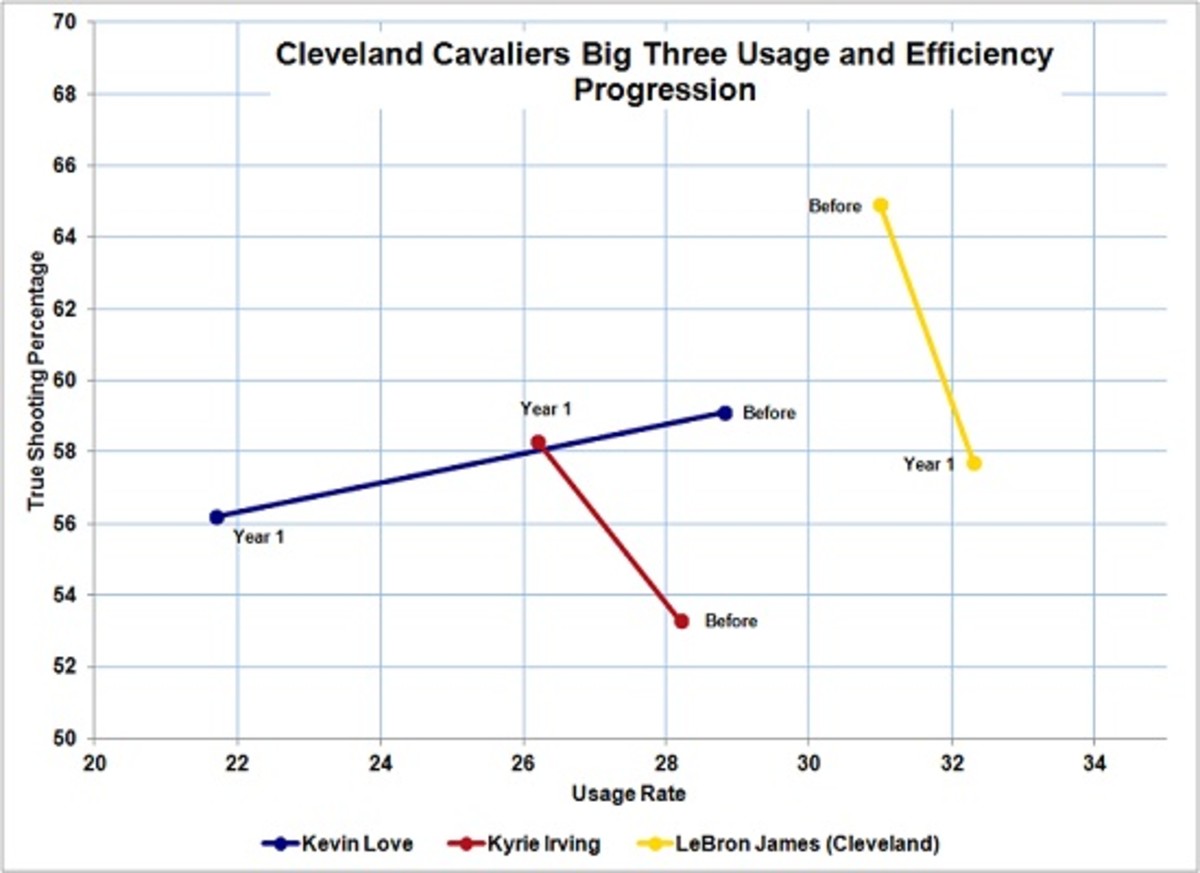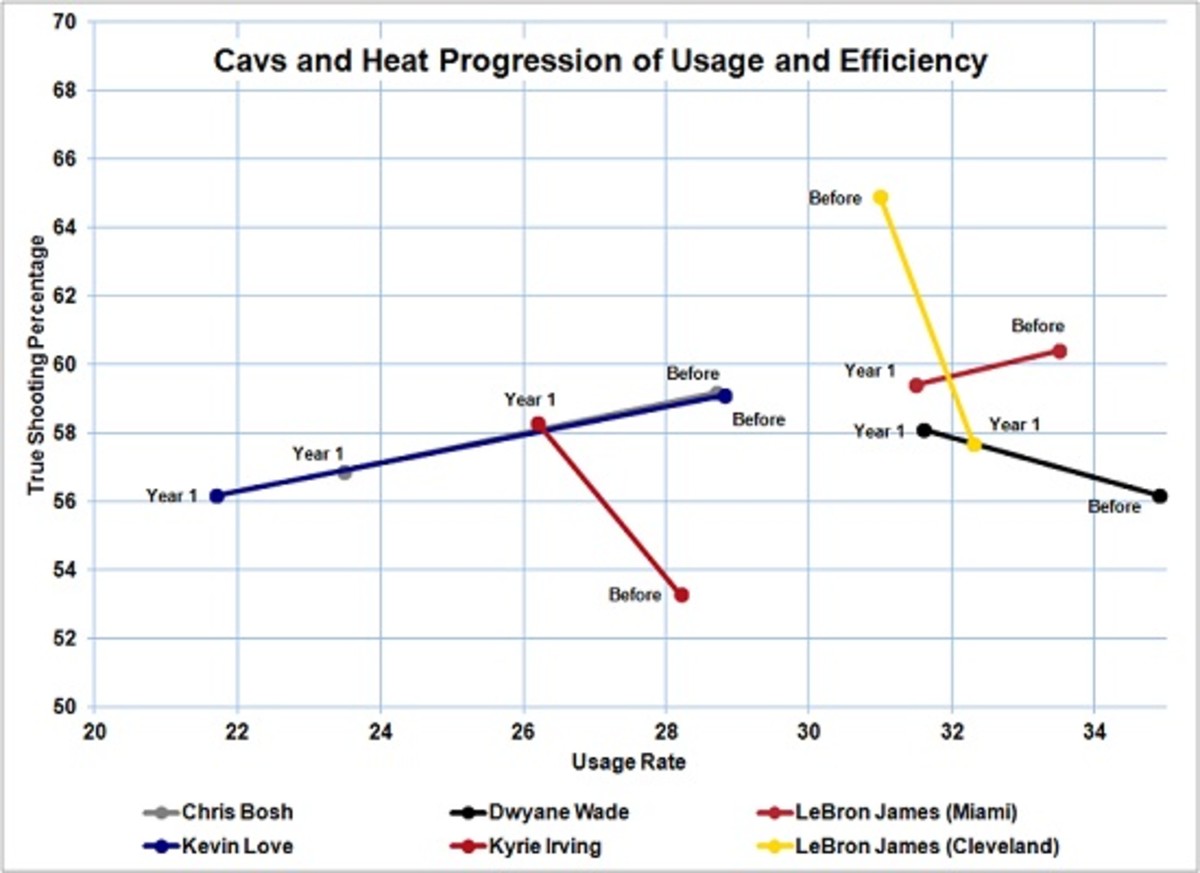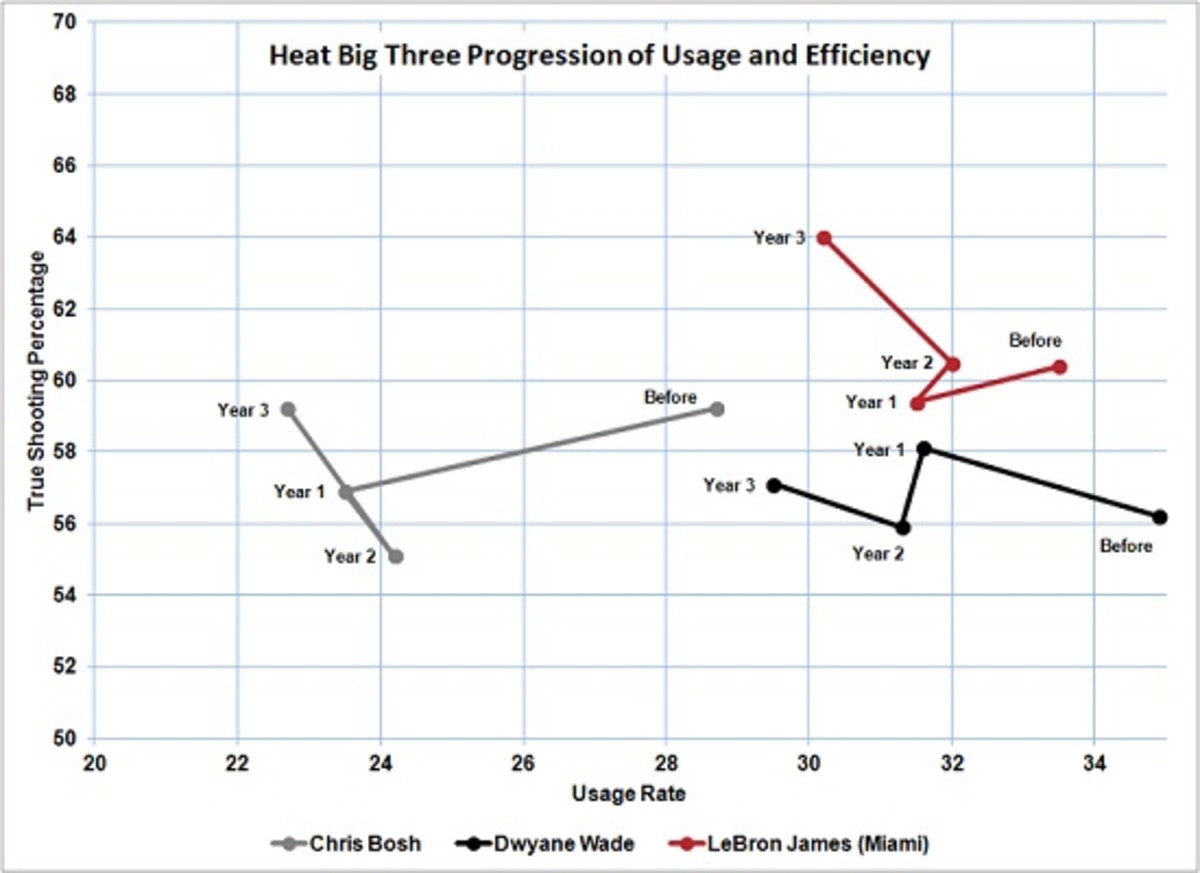Will the Cavaliers’ offense improve in Year 2 of LeBron’s return?

After losing to Golden State in last year's Finals, the Cavaliers have quickly become favorites to win the 2016 title. In the annual NBA general manager survey released earlier this week, the Cavaliers were selected by 29 GMs as the likely winners of the Eastern Conference, and picked by 16 to win the title. Cleveland also has the best Vegas odds to take home the league’s ultimate prize.
This attention is not wild, careless infatuation; the Cavaliers lost those Finals without two of their three best players, and they still have LeBron James. Still, the 2014-15 regular season was not an easy stroll for Cleveland and, although the Cavaliers eventually found a workable path, it often felt like they were grinding their own gears as much as grinding down their opponents.
This time last year, many fans and analysts (myself included) were broaching the possibility that the newly assembled Cavaliers could be one of the most efficient offenses in league history. LeBron was on the short list for best offensive player in the league. He would be surrounded by two other phenomenal offensive talents—Kyrie Irving, a dynamic ball-handler and shooter, and Kevin Love, a big who can post-up, pass from the elbows, and knock down three-pointers. Putting those three together, along with several other complementary scoring threats, seemed like a surefire recipe for offensive domination. It was reminiscent of the blinding optimism that ensued when LeBron helped coalesce the Miami Heat’s Big Three, except that Love is considerably more versatile offensively than Chris Bosh, and Kyrie Irving was just entering his prime, instead of sliding out of it as Dwyane Wade had been.
• MORE: Central Division preview: Cavs remain heavy favorites
Cleveland’s offense was phenomenal for large stretches of last season, and ended the year averaging 111.1 points per 100 possessions, according to basketball-reference.com. Far from a new historical precedent, that figure trailed both the Los Angeles Clippers and Golden State Warriors, and was just the 51st best mark of the last two decades. That level of efficiency was good enough for them last year, and would likely be good enough to get them another crack at a title this season, but it still seems to fall far short of their ceiling.
The statistical underpinning for projections of last season’s Cavaliers’ offense as historically elite was the relationship between usage and efficiency. The idea has become an indelible part of the basketball analytics canon: the larger an offensive load you carry, the harder it is to be efficient with it. A larger offensive load means more defensive attention and more responsibility for taking difficult shots no one else on your team can get off. As a player reduces their usage, they are theoretically able to focus on better, easier, more open shots, thus increasing efficiency.
Before joining forces, Irving, Love and LeBron were all efficient, high-usage players for their respective teams. It seemed they would each be able to lighten one another’s loads and increase one another’s efficiency by sharing responsibility more equally. Before the season began, I projected that LeBron’s ability to reduce the usage rates of Irving and Love could be worth anywhere from +2.1 to +5.3 points per 100 possessions by increasing the scoring efficiency of his teammates.
That projection really only worked out for Irving, who reduced his usage rate and increased his true shooting percentage significantly. LeBron actually increased his offensive load as compared to his final season in Miami, and his true shooting percentage declined dramatically, from 64.9% to 57.7%. Love reduced his usage rate significantly but also scored less efficiently, sporting a true shooting percentage decline from 59.1% to 56.2%.
The graph below shows how the usage and efficiency for player changed from their last season apart to their first season together:

It is not a perfect analogy, but this progression is fairly similar to what happened when Bosh, Wade and LeBron first teamed up in Miami.

The slope of Kevin Love’s decline is essentially identical to what happened with Chris Bosh in his first season with the Heat. Irving and Wade saw roughly similar changes, although Wade was working on a different tier of usage, so the improvement was slightly smaller. The major difference between the two scenarios is LeBron Then vs. LeBron Now.
Tristan Thompson’s deal with Cavs extension of ‘title or bust’ philosophy
When LeBron joined the Heat, he saw a slight drop in both his usage and efficiency—a function of playing a very similar role but sharing ball-handling responsibilities with Wade. By the time he left Miami, LeBron’s role had changed completely. He had a more versatile offensive role in which he was more productive. After playing from a variety of areas on the floor in an offense where the ball was moving fairly continuously in Miami, he returned to Cleveland and the somewhat stagnant high pick-and-roll attack that had characterized his first run with the team.
Over at Hardwood Paroxysm, Adam Mares dug into the changes LeBron initiated last season and implored him to work more off the ball.
LeBron’s regular season time of possession rose from 5.1 minutes per game in 2014 to 6.1 minutes per game in 2015, despite playing 1.9 fewer minutes per game. Put another way, LeBron had the ball in his hands 16.9% of the time he was on the court with the Cavs last year, compared to just 13.5% of the time in Miami the season before.
In the times that LeBron spends off-ball, he tends to be relatively stagnant. According to Synergy data, in 69 regular season games, LeBron finished the play as the screener in pick-and-rolls just 12 times. In those 12 plays, LeBron scored 17 points. The absurdly small sample size is more telling than the efficiency. Why did only 12 of LeBron’s attempts or turnovers come from him rolling off of a ball screen, especially when he was playing with such a great pick-and-roll ball-handler in Kyrie Irving?
LeBron’s efficiency peaked in Miami because his versatility peaked, as well. Moving between on the ball and off it, spotting up, crashing in the post, and running high pick-and-rolls more judiciously (and often after an initial action sent the defense scrambling) is what let him break the norms of that relationship between usage and efficiency. Instead of sharing the ball in Cleveland and becoming more efficient, he had the ball more and produced less.
As for Love, his role was likely going to decrease the most of the Cavaliers' trio, but his efficiency suffered in puzzling ways last season. He attempted an identical number of catch-and-shoot three-pointers per game between Minnesota and Cleveland, where one might have expected him to see slightly more next to Irving and LeBron. His percentage on those catch-and-shoot threes declined from 39.8% to 37.1% and not by virtue of increased defensive attention — roughly 88% of his three-pointers were classified as open or wide open by the SportVU player tracking statistics for both of the last two seasons. Love struggled through back pain for much of the year and clearly didn’t adapt well to his new role.
2015–16 NBA entertainment rankings
. "I hope that I get different looks this year. I mean, there will be times where I’ll still end up at my sweet spot, but throwing out different plays and pick-and-rolls, I’m hoping to expand my game all over the court."
All this underlines the point that context is difficult to account for when applying basketball statistics to real-life collaborations. Like the Miami Heat before them, the math on Cleveland’s new offense was not as simple as 1+1+1=3. Their talent will have to grow into the system and their roles, which will likely be fine-tuned and adjusted this year and beyond.
If we return to the graphs and stretch the last one over a few more seasons, we see that Year 2 of the Heat’s collaboration was actually worse for both Wade and Bosh. It wasn’t until the playoffs at the end of that season when an injury to Bosh forced the small-ball adaptation, that the Heat’s offense became dominant.

The Cavaliers certainly have the talent to win the Finals this year. Looking again at LeBron’s Heat as a comparison, that team made the four straight trips to the Finals and won it all in years two and three, even though years three and four may have been a better approximation of the team’s ceiling. The scary thing about Cleveland, and probably what’s driving their title-favorite status, is the recognition of how good they were last year despite muddling through so many different problems with mediocre solutions. They were nowhere near their best, and they were still really good.
It’s not hard to see how Cleveland could improve dramatically this year. Kevin Love’s three-point percentage could bounce back and he could find some more diverse ways to contribute to the offense. LeBron could help facilitate that by letting go of the ball a little more, and using his insane versatility to fill in the cracks. Cleveland also gets a full season from the key supporting parts they picked up at the trade deadline — J.R. Smith, Iman Shumpert and Timofey Mozgov. If history is any example, their offense is going to improve. It might take another year of muddling for them to solidify into the best version of themselves, but the day is on the horizon.
In the meantime, another year of muddling may still be enough.

